
Understanding the landscape of competition is crucial for any business aiming to carve out a significant market share. From the early market stalls of ancient civilizations to today’s digital storefronts, competition has driven innovation, customer service, and product quality. Here’s a straightforward look at how competitors shape the business environment and why knowing them well can turn potential threats into opportunities.
A competitor in business is any entity that offers a product or service that could satisfy the same customer needs as another company. In the bustling marketplaces of commerce, competitors push each other to constantly improve, adjust, and innovate. Whether they operate on a local or global scale, understanding who your competitors are is the first step in crafting strategies that highlight your unique advantages and appeal to your target audience.
To effectively identify your business competitors, start by analyzing your market segment.
Look at who is currently engaging with your target customers and understand the strengths and weaknesses of these competitors.
This includes examining their product offerings, market positioning, pricing strategies, and customer feedback.
Tools wtih social media analysis and customer surveys like competitors.app can also provide invaluable insights into who you’re really competing against.
In any market, a competitor in business is an entity that poses a challenge to your company by offering a similar product or service to the same customer base. This competitive presence isn’t just about rivalry; it’s a dynamic force that propels innovation and drives businesses to continuously improve their offerings. Competitors can range from vast, multinational companies to small, local startups, and each one plays a specific role in shaping the strategies of all businesses in the market.
Identifying competitors involves more than recognizing other businesses selling similar products; it requires a deep understanding of your market, including customer preferences, emerging trends, and potential gaps that competitors might exploit. Tools such as market research, competitive analysis, and customer feedback are essential in painting a complete picture of who your competitors are and how they operate.
Pinpointing who your key competitors are is crucial to understanding your own position in the marketplace. This identification process involves a mix of research and strategy. Start by examining your direct competitors, which are businesses that offer the same products or services as you do to the same customer demographics. This group is often the easiest to identify and the most critical to understand because their actions can directly affect your business’s success. To effectively identify competitors:

Use tools like surveys, interviews, and focus groups to gather information about consumer preferences and behaviors.
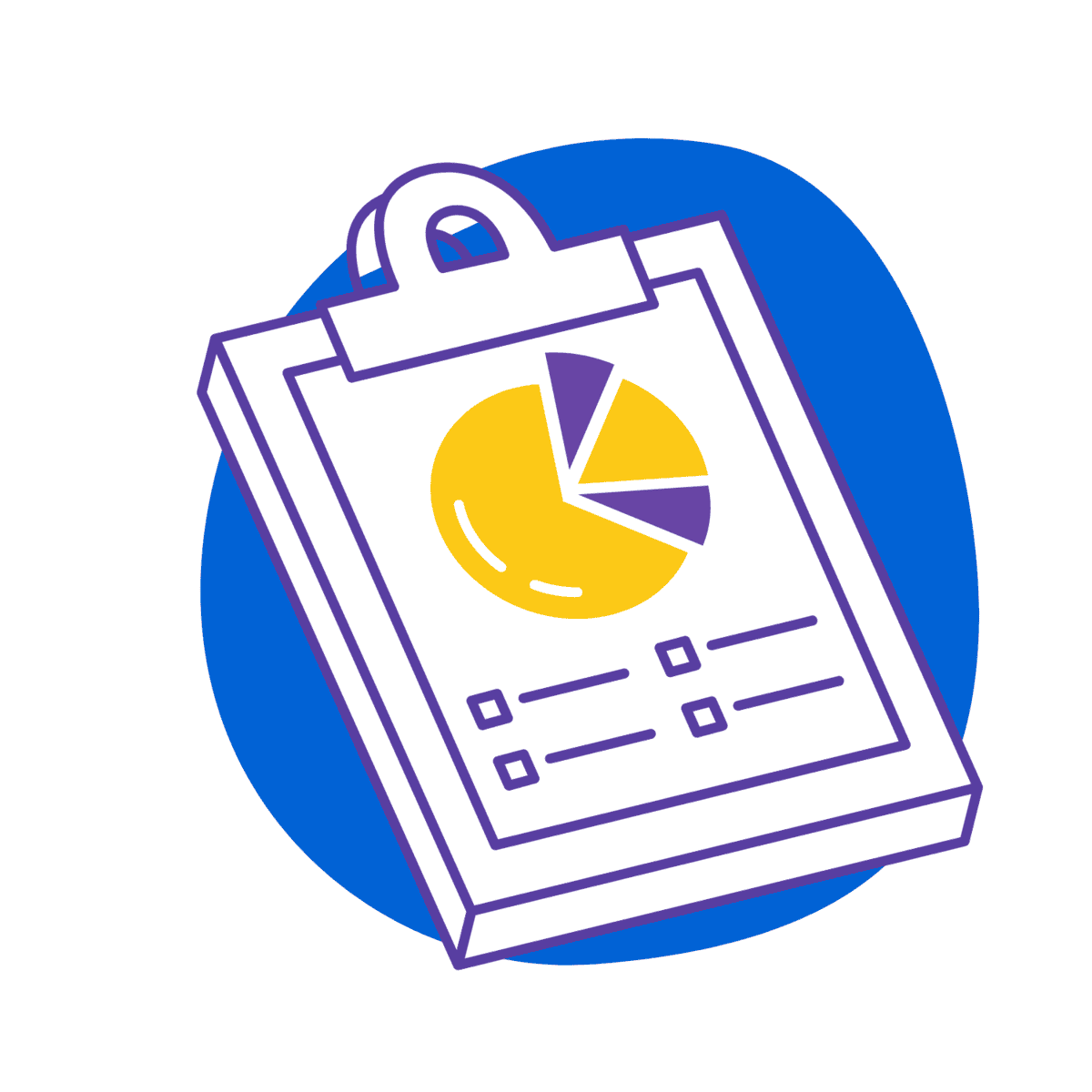
These can provide insights into market trends, growth patterns, and the competitive landscape.

Observing competitors’ digital presence can help you gauge their marketing strategies, customer engagement, and brand positioning.
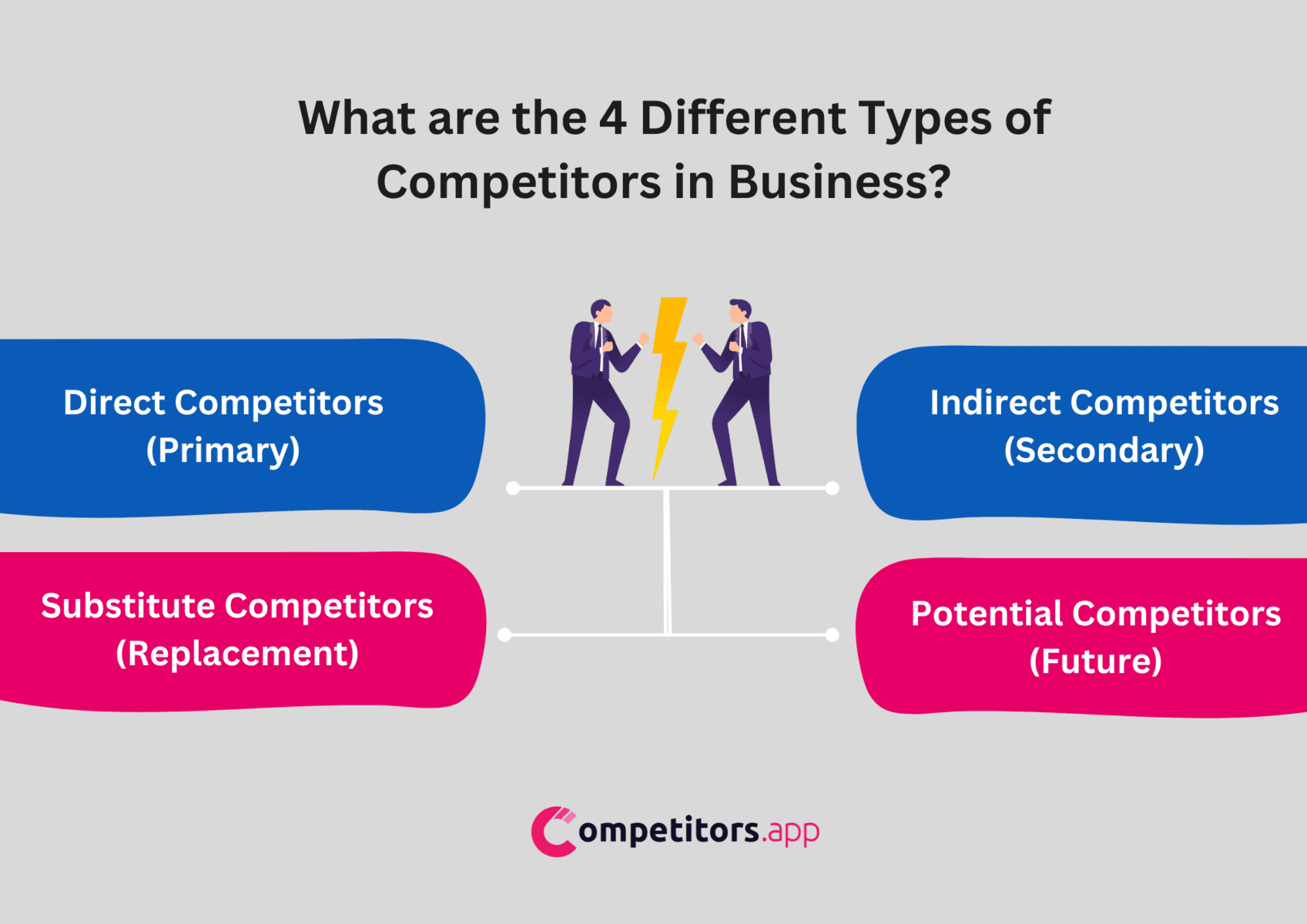
The concept of competitors in business can be broken down into several categories, each representing a different type of challenge and opportunity for your company. Based on the breakdown from sources like Klue, here are the four different types of competitors you might encounter in business:
Direct competitors are businesses that offer a product or service that is virtually identical to yours. They target the same audience and compete directly for the same market share. This is the most straightforward type of competition, where both businesses vie for customer attention based on price, quality, service, and other differentiating factors.
If you run a coffee shop, a direct competitor would be another coffee shop in the same neighborhood offering a similar menu and ambiance.
Indirect competitors are those that provide a product or service that isn’t the same as yours but serves the same need or solves the same problem. These competitors might not always be obvious because they operate in different categories, yet they capture part of your potential market by fulfilling the same customer requirements through alternative solutions.
For a movie theater, an indirect competitor might be a streaming service like Netflix or Hulu, as both provide entertainment options, albeit in different formats.
Substitute competitors offer alternative products or services that customers might choose over yours, even if they differ significantly in form. These substitutes can replace the need for your product as they provide another way to achieve the same goal.
A great example is the relationship between bottled water companies and home water filtration systems. Both serve the need for clean drinking water, but in very different ways.
Potential competitors are not currently in your market but have the capability to enter it quickly. These might include companies that are currently in other markets or new startups that are emerging with new technologies or business models that could disrupt existing market conditions.
A technology company outside the automotive industry developing autonomous driving software could potentially become a significant competitor to traditional car manufacturers.
In addition to the primary categories of competitors, there are various other forms of competition that can impact a business. These are often shaped by broader industry dynamics, market segmentation, or technological innovations. Understanding these can further refine a company’s competitive strategy and market positioning.
Industry giants are large companies that dominate the market, often enjoying substantial brand recognition and customer loyalty. Their size and scale offer them significant advantages in terms of resources, reach, and influence.
Example:
In the tech industry, companies like Google and Microsoft serve as industry giants, setting standards and often dictating the pace and direction of innovation and market trends.
Niche players specialize in a particular segment of the market. These companies may offer specialized products or services that cater to specific customer needs, often under-served by larger competitors. They thrive by deeply understanding and meeting the unique requirements of their target audience.
Example:
A company that produces vegan, cruelty-free cosmetics targets a specific consumer niche that values ethical, animal-free beauty products.
Local competitors operate in the same geographic area as your business. They might not offer the same level of products or services but compete for the same local customer base. The competition with local businesses is often more direct and can be influenced by community engagement and local business networks.
Example:
For a small family-run restaurant, other local dining establishments, regardless of cuisine, act as competitors within the same town or neighborhood.
These are businesses that operate across international borders. They bring different practices, economies of scale, and potentially lower costs due to their global presence, which can pose a significant challenge to local businesses.
Example:
A furniture manufacturer in the U.S. may face competition from international companies that can produce similar items at a lower cost due to cheaper labor and materials available in other countries.
With the rise of e-commerce, many businesses now compete with others that operate entirely online. These competitors can reach a global audience, often offering lower prices due to reduced overhead costs.
Example:
Traditional brick-and-mortar bookstores face intense competition from online retailers like Amazon, which offers a vast selection of books at competitive prices with the convenience of home delivery.
Innovators and disruptors are companies that challenge the status quo by introducing groundbreaking products, services, or business models that redefine markets. These competitors can quickly rise to dominance if their innovations meet untapped customer needs or offer substantial improvements over existing solutions.
Example:
Tesla disrupted the automotive industry by mainstreaming electric vehicles and focusing on sustainability and high performance, challenging traditional automakers to accelerate their own electric vehicle offerings.

Identifying your main competitors is a foundational step in strategic business planning. It involves more than just recognizing who else is selling similar products—it’s about understanding your position in the marketplace and anticipating challenges and opportunities. Here are some practical steps and methodologies to accurately identify and analyze your main competitors:
Begin with broad market research to get a sense of the landscape. This can involve:
– Industry Reports: Leverage published reports from market research firms which often include lists of key players in various segments.
– Trade Journals and Publication: These can provide insights into who is leading the market, who is innovating, and any shifts in market dynamics.
– Online Marketplaces and Platforms: Checking platforms like Amazon, eBay, or industry-specific platforms can reveal who are the top sellers and what products they offer.
Your current customers can provide valuable insights into who they consider when making purchasing decisions. Surveys, feedback forms, and even informal conversations can reveal competitors you might not have considered.
Search engines are powerful tools for identifying competitors:
– Search Queries: Perform searches for your products or services and see who else shows up in the search results and advertisements.
– Keyword Tools: Use SEO tools like SEMrush, Ahrefs, or Google Keyword Planner to see who ranks for the same keywords you are targeting.
Social media platforms like Twitter, Facebook, LinkedIn, and Instagram can provide real-time data on who is gaining traction in your market:
– Follow Hashtags: See what companies pop up regularly in industry-related hashtags.
– Monitor Competitors’ Activity: Track their engagement rates, follower growth, and content strategy.
Sometimes, the best way to understand your competitors is by experiencing their products or services firsthand:
– Purchase Products: Buy their products to evaluate quality, customer service, and pricing.
– Subscribe to Services: Use their services to understand the customer journey and what might appeal to shared target audiences.
Trade shows, exhibitions, and industry conferences are excellent places to learn about your competitors. These events provide a direct look at how they market themselves, their latest product offerings, and the chance to see their products in action.
Checking for new patents, trademark filings, or regulatory submissions can provide early warnings about potential new products or market entries from existing or new competitors.
For publicly traded companies, annual reports and financial statements can offer deep insights into a company’s strategy, market positioning, and areas of investment.
Leverage your professional network to gain insider knowledge about market movements and competitor strategies. Conversations with suppliers, distributors, and even former employees can provide unexpected insights.
Google Alerts is a simple yet effective tool for keeping tabs on competitors. Set up alerts for the company names of your major competitors, key executives, and specific products. This will ensure you receive regular updates on news articles, press releases, and other relevant mentions across the web.
There are numerous tools available that specialize in competitive analysis, such as:
– Competitors.app: Monitors competitors’ website changes, social media activities, email newsletters, and more, providing a holistic view of their marketing strategies.
– SEMrush: Provides detailed insights into competitors’ SEO strategies, keyword rankings, and content marketing efforts.
– Ahrefs: Offers comprehensive tools for tracking backlinks, keywords, and content, giving a view into your competitors’ SEO and content strategy.
Social media platforms are a goldmine of information regarding how competitors engage with their audience and how their branding efforts are received:
– Tools like competitors.app or Hootsuite: Allow you to monitor mentions, hashtags, and responses related to your competitors.
– Analyzing Engagement: Look at how often your competitors post, what content receives the most engagement, and how they interact with their audience.
By subscribing to your competitors’ newsletters and following their blogs, you gain direct insights into their marketing tactics, new product launches, and customer engagement strategies.
Trade shows and conferences not only allow you to showcase your products but also to see what your competitors are unveiling. These events can provide insights into new technology, strategic shifts, or new market focuses your competitors are adopting.
For competitors that are public companies, quarterly and annual reports are invaluable resources. These documents provide a wealth of information about a company’s financial health, strategic priorities, and new initiatives.
Listening to customer feedback on your own and your competitors’ products can provide direct insights into what is working and what isn’t. This can be through online reviews, feedback forms, or customer service interactions.
Regularly compare your business metrics against your competitors’. Metrics can include market share, growth rate, customer retention rates, and product innovation. Tools like Nielsen and IBISWorld can aid in obtaining industry-specific data.
Mystery shopping, either online or in-person, can reveal how competitors are performing in terms of customer service, product quality, and in-store or online shopping experience.
Industry analysts often have a deep understanding of the market and can provide insights into competitor strategies that may not be visible through public channels.
Monitoring your competitors is not about copying what they do, but rather understanding their strategies to improve your own business decisions. Regularly updating your approach to monitoring can provide a strategic advantage, helping you adapt to changes in the competitive landscape more swiftly and effectively.
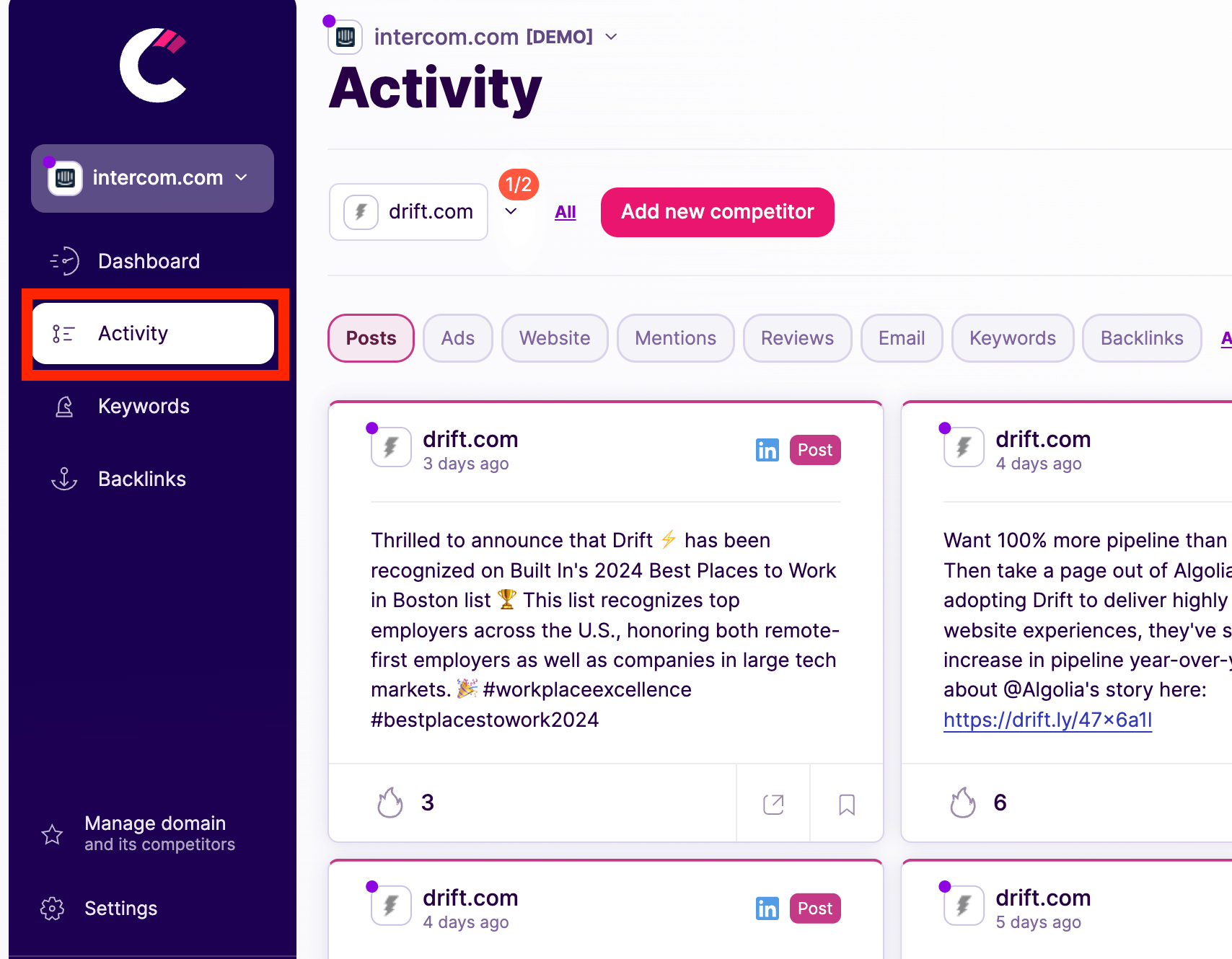
Keeping a close eye on your competitors is essential for staying ahead in the competitive landscape. With the right tools and strategies, you can gain valuable insights that can inform your business decisions and strategic moves. One such tool that can significantly aid in this effort is Competitors.app.
Keeping a close eye on your competitors is essential for staying ahead in the competitive landscape. With the right tools and strategies, you can gain valuable insights that can inform your business decisions and strategic moves. One such tool that can significantly aid in this effort is Competitors.app.
Competitors.app is a cloud-based monitoring tool that simplifies the process of tracking your competitors. It allows you to keep an eye on various aspects of their business, including website changes, social media activity, email newsletters, and more. This comprehensive approach ensures that you don’t miss out on any critical updates or strategic shifts that could impact your market position.
– Website Monitoring: Tracks any changes made to competitors’ websites, such as new products, pricing updates, or changes in their service offerings.
– Social Media Tracking: Provides insights into your competitors’ social media presence and campaigns across platforms like Facebook, Twitter, and Instagram.
– Email Newsletter Insights: By monitoring the newsletters that your competitors send to their subscribers, you can gain insights into upcoming promotions, new product announcements, or strategic communications.
– SEO and Ad Monitoring: Keeps tabs on competitors’ search engine optimization and advertising strategies, giving you a clearer picture of their tactics to attract and convert customers.
1. Set Up Tracking: Start by adding the competitors you want to monitor. Competitors.app will require basic information such as competitor company names, their website URLs, and other relevant details.
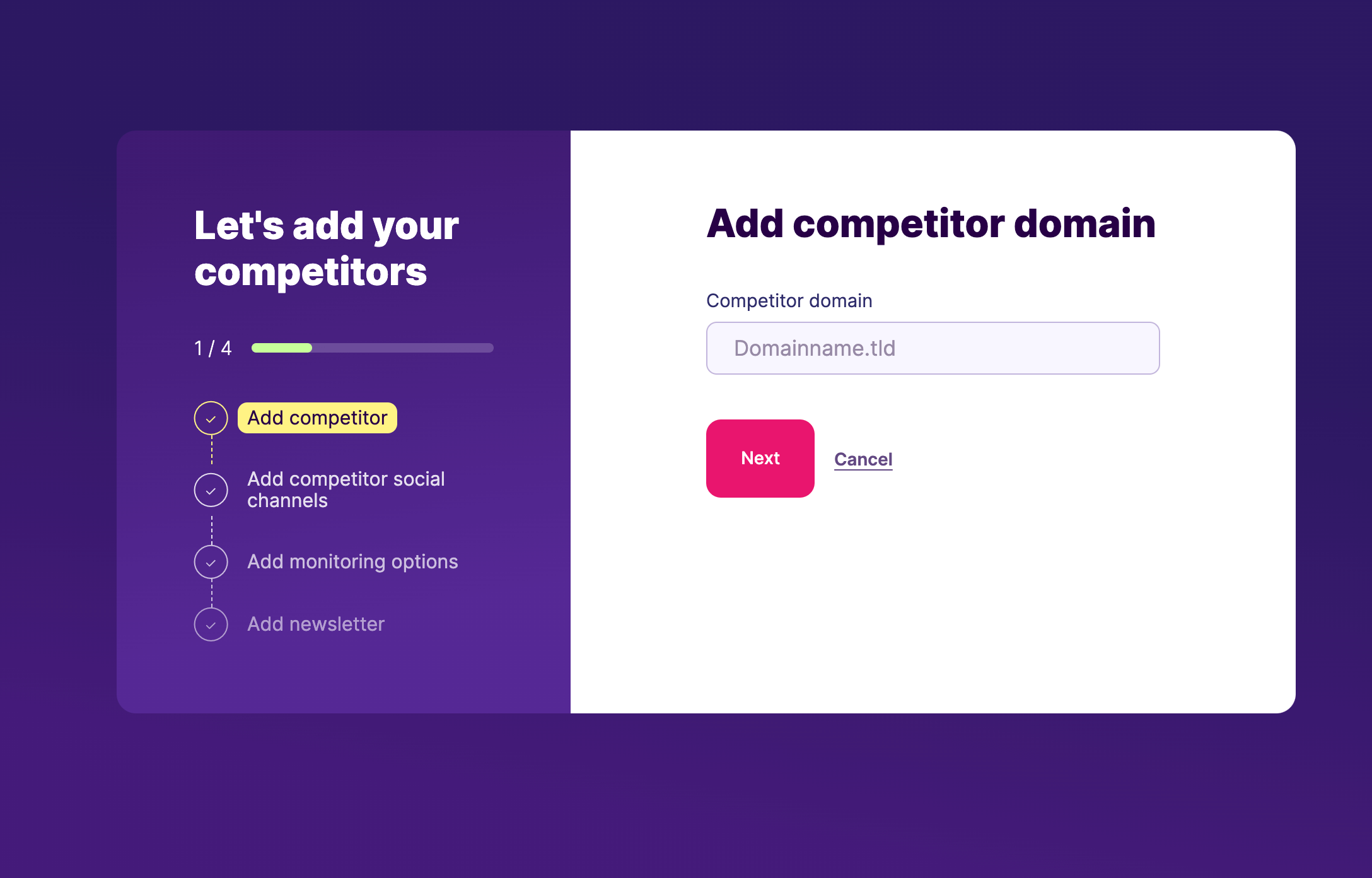
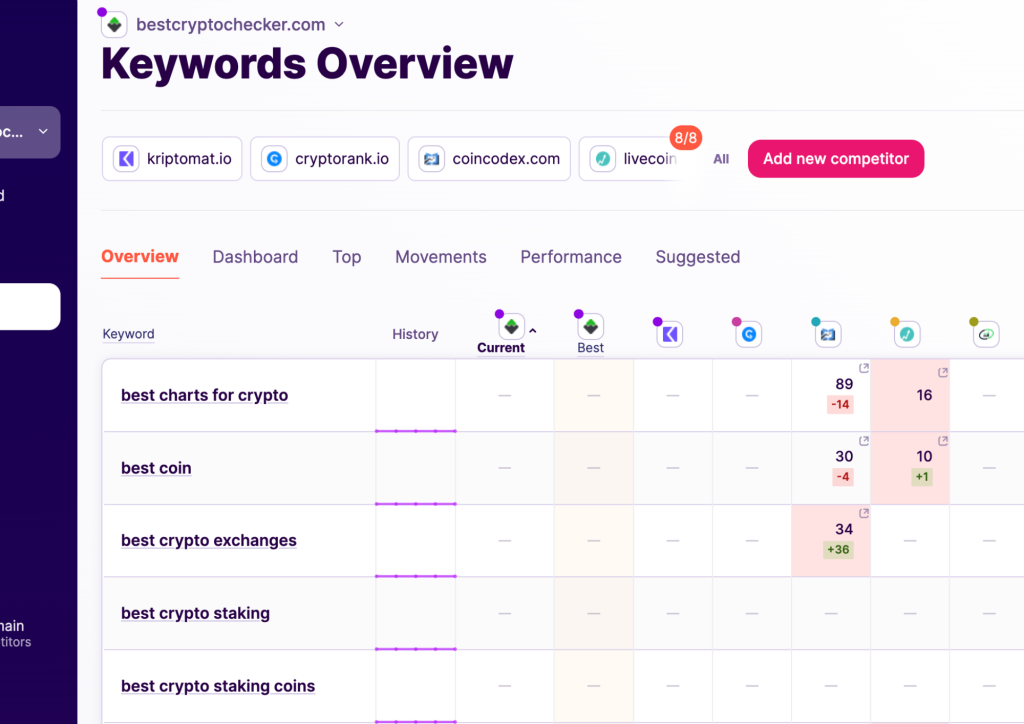
2. Customize Alerts: Customize the alerts you receive based on specific keywords, changes, or updates that are most relevant to your strategic interests. This ensures that you receive notifications that are actionable and pertinent to your business.
3. Analyze Data: Utilize the data collected by Competitors.app to analyze your competitors’ moves. Look for patterns or shifts in their strategies that might indicate new market trends or changes in consumer preferences.
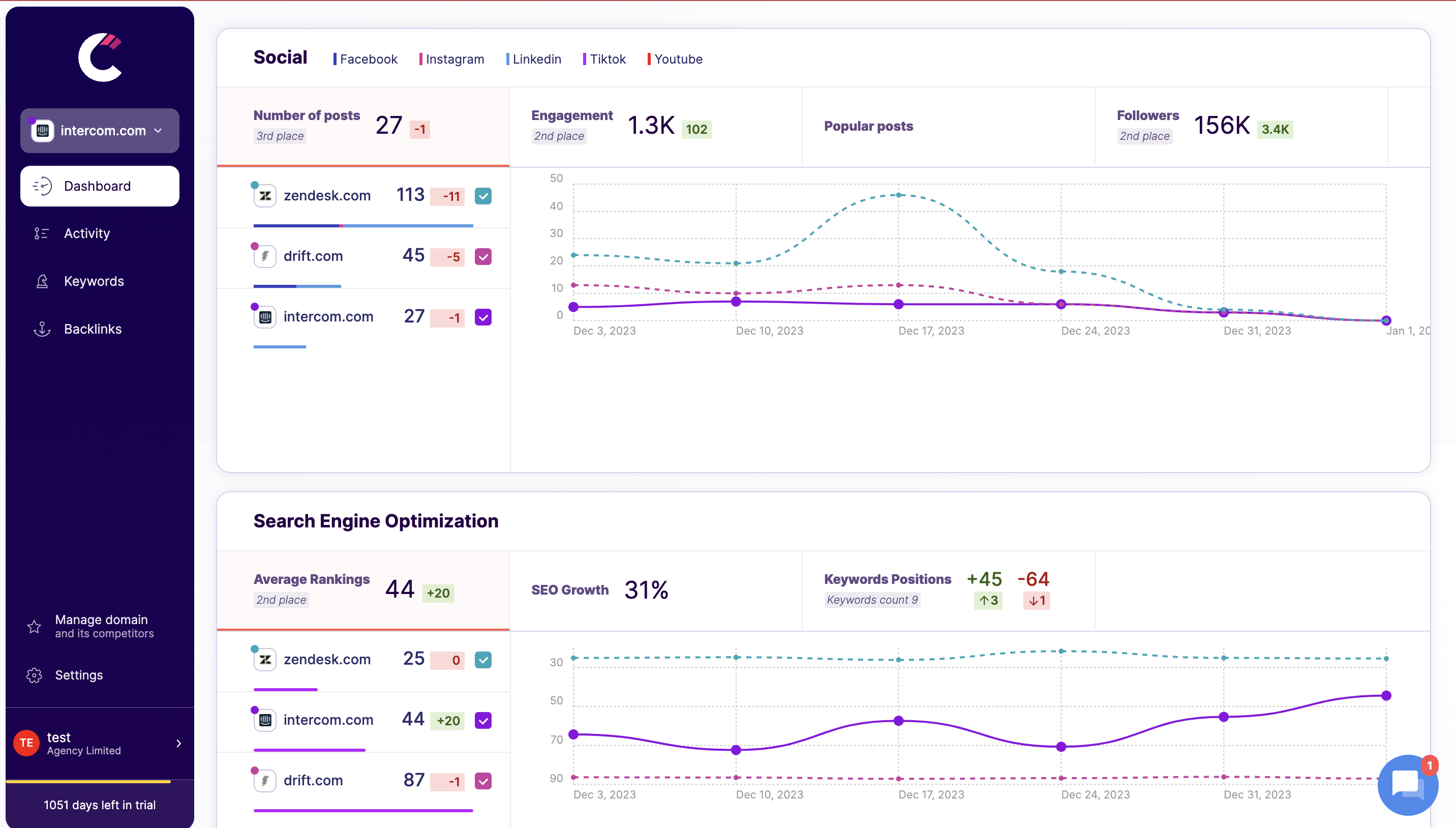
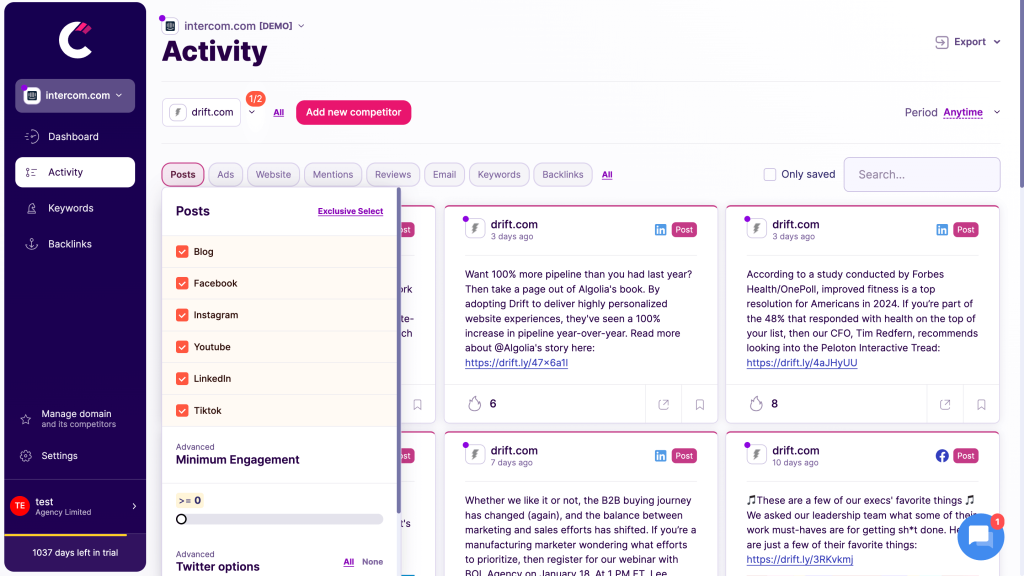
5. Regular Reviews: Regularly review the insights provided by Competitors.app to keep your competitive analysis current. Markets evolve, and so do competitors’ strategies, so continuous monitoring is crucial.
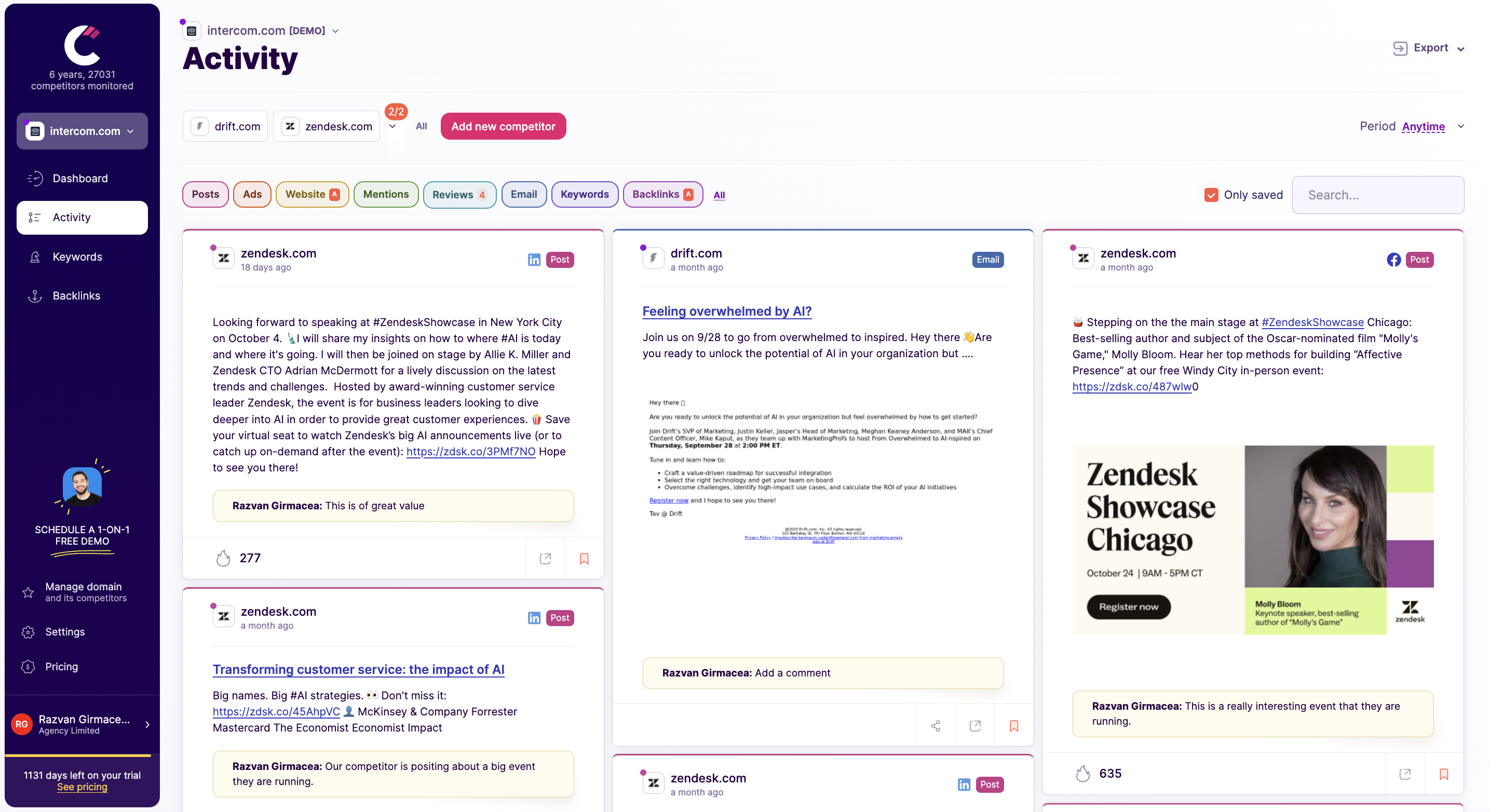
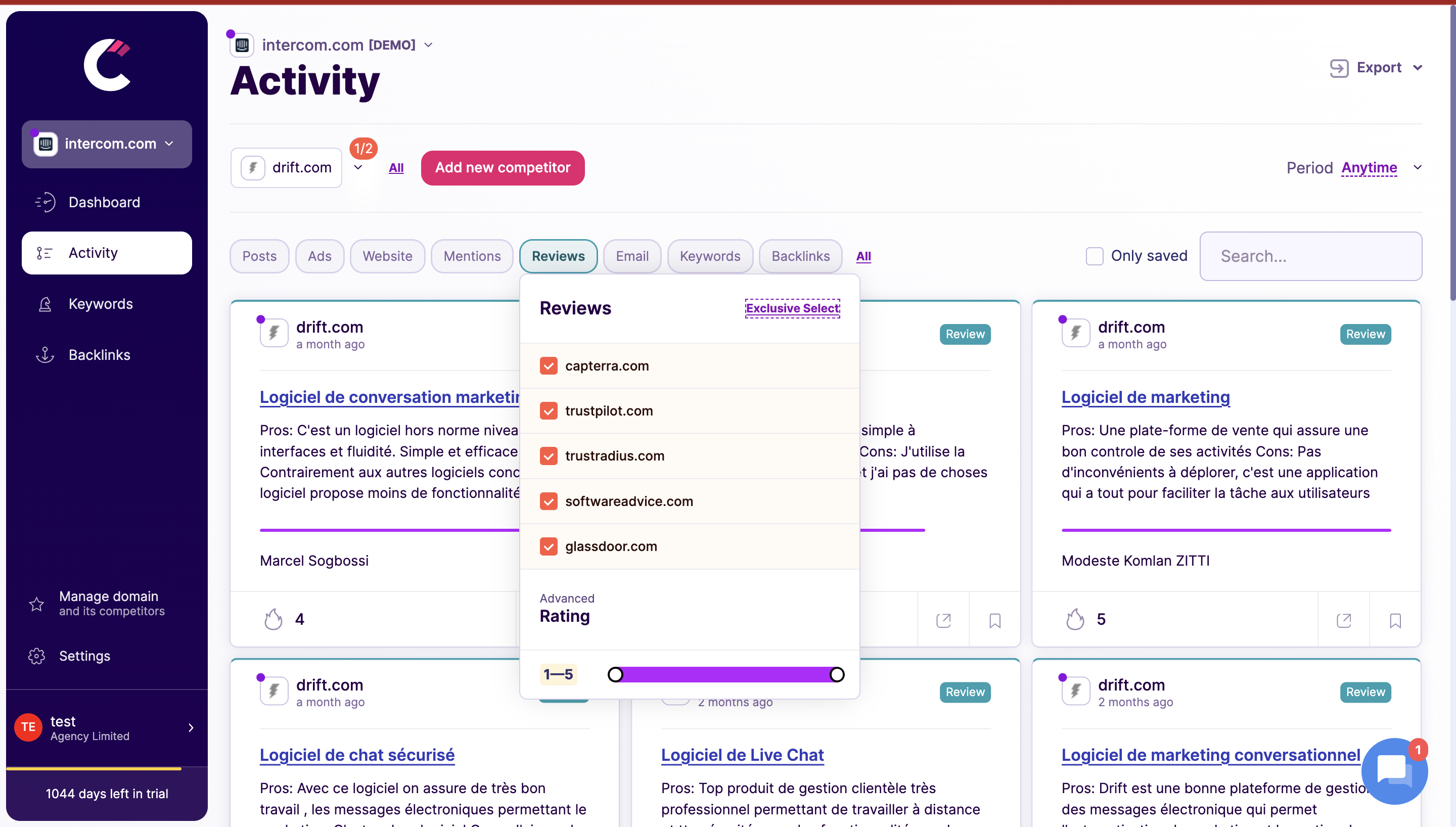
Leveraging Competitor Insights for Growth
The insights gathered through Competitors.app should be integrated into your strategic planning. Use this information to:
– Identify Opportunities: Spot gaps in competitors’ offerings or areas where they are underperforming and capitalize on these opportunities.
– Enhance Customer Engagement: If you notice competitors engaging with their audience in new and effective ways, consider how you can adapt or improve these strategies for your audience.
– Optimize Product Development: Stay informed about new products or services your competitors are launching and consider how you can innovate your offerings to stay competitive.
Gaining a competitive advantage requires a multifaceted approach that includes strategic planning, continuous innovation, and deep market understanding. Here are some effective strategies to help your business stand out and stay ahead of the competition:
1. Capitalize on Your Unique Selling Proposition (USP)
Identify and emphasize what sets your product or service apart. This could be quality, price, innovation, customer service, or any other attribute that sets you apart from your competitors. Articulating your USP clearly attracts and retains customers who are specifically looking for what you offer.
2. Enhance the Customer Experience
A superior customer experience can significantly set your business apart. This spans all interactions from the initial contact to post-purchase support. Exceptional customer service and a tailored customer journey can transform customers into dedicated advocates of your brand.
3. Embrace Technology and Innovation
Stay at the forefront by adopting cutting-edge technologies and innovative practices in your business operations. Whether it’s advanced analytics to better understand customer behaviors, AI to boost service efficiency, or the latest marketing technologies to increase engagement, staying innovative is key.
4. Foster Brand Loyalty
Cultivating strong brand loyalty ensures customers continue choosing you over competitors, even when offerings are similar. Achieve this through consistent branding, fostering a community around your brand, and maintaining active engagement with your audience.
5. Boost Operational Efficiency
Enhancing operational efficiency can cut costs and improve product quality. Streamline your processes, minimize waste, and ensure every component of your business is optimized for peak performance.
6. Promote Continuous Learning and Improvement
Foster a culture of learning and continuous improvement within your organization. Keep abreast of industry trends and adapt your business strategies to stay relevant. Regular training and development programs can keep your team knowledgeable and motivated.
7. Engage in Strategic Networking
Cultivate strategic partnerships and networks that provide mutual benefits. Networking can lead to new opportunities, such as accessing new markets, resource sharing, or collaborative marketing ventures.
8. Secure Your Intellectual Property
Protect your innovations, brands, and creative works under intellectual property laws. This not only safeguards your assets but also establishes a competitive barrier to entry for others.
For further reading on strategies to gain a competitive advantage, consider the following resources:
In the relentless pursuit of business success, understanding and adapting to the types of competitors you face is crucial. By identifying and monitoring your direct, indirect, substitute, and potential competitors, you can craft strategies that not only counteract their moves but also propel your business forward. Leveraging tools like Competitors.app and implementing the strategies discussed can help you maintain a competitive edge. Remember, the goal is not just to compete but to set a standard and lead in your industry. Whether through innovation, customer service, or operational excellence, strive to be a company that others look up to and aspire to beat.
Yes, besides the primary types such as direct, indirect, substitute, and potential competitors, marketing can also involve competition from content and channel competition. Content competition involves competing for audience attention through content marketing efforts across various platforms. Channel competition occurs when companies vie for the same marketing or distribution channels to reach consumers, such as competing brands selling through a popular retail website or physical store.
Tertiary competition refers to competitors that are not directly related to your core product or service but may capture the discretionary spending of your potential customers. For example, a movie theater might consider a nearby restaurant as tertiary competition, as both compete for the same leisure spending dollars.
Indirect competitors play a crucial role by providing alternative solutions or products that meet similar customer needs. They push businesses to innovate and diversify their offerings. Understanding indirect competitors helps firms anticipate broader market shifts and adapt their strategies to capture various customer segments.
Studying industry giants offers valuable lessons in scalability, market penetration, product development, and brand loyalty. Large companies often set industry standards and best practices in operations, customer service, and marketing. Analyzing their successes and failures can provide strategic insights and help smaller businesses identify opportunities for differentiation and innovation.
Understanding local competitors is vital because they directly affect your market share in the community. Local competitors influence consumer preferences and expectations, pricing strategies, and promotional tactics. For small and medium businesses, local competitors often pose the most immediate threat, and successfully competing with them can lead to stronger community ties and customer loyalty.
Examples of disruptors include companies like Uber in transportation, Airbnb in hospitality, and Netflix in entertainment. These companies revolutionized their respective industries by changing how services are delivered and consumed, often leveraging technology to bypass traditional business models and connect directly with consumers.
Positioning against substitute competitors involves emphasizing the unique benefits of your products or services that substitutes cannot match. This might include superior quality, better customer service, additional features, or stronger brand values. It's also effective to build strong customer relationships and loyalty programs that make switching to a substitute less appealing.
Tertiary competitors are businesses that do not compete in the same category or market but compete for the same limited customer resources, such as time or money. For example, a bookshop, a cafe, and a cinema might all compete for the same leisure spending but not sell competing products directly. Understanding tertiary competition helps businesses strategize on broader consumer behavior trends and spending patterns.
Competitors App SRL
support at competitors.app
Sanzienelor 3, Sibiu, Romania
+1 (302) 208-7954